It was only about ten years ago that hybrid meant economy car. A Prius, for instance. Today, it means almost every new model luxury sedan – like this 2022 Audi A6 – as well as its primary rivals, the BMW 5 Series and Mercedes E-Class sedans.
These three all cost twice as much as a Prius. Nor do they deliver particularly impressive gas mileage numbers.
Which doesn’t make them very economical.
But the hybrid configuration does make them possible.
The A6 is Audi’s mid-sized entrant in the luxury sport-sedan class. It traditionally competes with others in the class like the BMW 5 and Mercedes E by touting its standard all-wheel-drive (the BMW and Benz offer AWD) as well as its more subtly affluent demeanor.
Prices start at $55,900 for the Premium trim equipped with a 2.0 liter/hybrid (and all-wheel-drive) powertrain; there’s an option to replace the 2.0 liter engine with a much more powerful 3.0 liter V6 – also paired up with a hybrid/AWD rest of the drivetrain.
It stickers for $59,800
Next up is the Premium Plus – which also offers the choice of either the 2.0 or the 3.0 hybrid/AWD powertrain and comes standard with the heated steering wheel and wireless charging which are optional with the Premium trim – and adds an upgraded 16 speaker audio system, LED headlights and the option to buy the Executive Package, which bundles four-way climate control, heated rear seats, a power trunk opener and configurable interior LED lighting.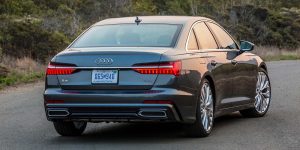
It stickers for $59,800 with the 2.0 engine and $63,700 with the 3.0 V6.
A top-of-the-line Prestige trim comes standard with the V6 (and AWD) as well as everything that’s optional in the Premium Plus – including the Executive Package – plus power soft-closing doors like those used in the top-of-the-line A8, power rear and side sunshades and the option to get massaging seats – a feature you used to have to buy the top-of-the-line (and larger) A8 to get.
What’s New
The Black Optics Sport package – which includes 20-inch wheels and a lowered ride height – is now available with any of the three trims.
The standard Virtual Cockpit Plus digital instrument panel has also been upgraded in all trims.
What’s Good
Standard AWD – for about as much as rivals charge for the rear-drive versions of their A6 competitors.
Strongest standard four in the class.
Options – such as massaging seats – you didn’t used to be able to get in this class.
What’s Not So Good
Hybrid drivetrains don’t do much for gas mileage.
Not much space in the trunk (13.7 cubic feet).
Digital dashboard may not age well.
Like most of the rest in this class – including the BMW 5 and Mercedes E – the A6 comes standard with a hybrid drivetrain.
But not so much for the sake of gas mileage – as in the case of traditional hybrids like the Prius.
The A6’s standard hybrid drivetrain consists of a turbocharged 2.0 liter four cylinder engine paired with a seven speed automatic and AWD. The hybrid part of the set-up is a 48 volt electrical system and high-torque belt-driven starter that cycles the gas engine off and on depending on the need for it to be on or not.
It works on the same principle as the mild hybrid systems used in the BMW 5 and the Benz E, which use a 48 volt electrical system to power a flywheel-mounted starter/generator that serves the same purpose. The idea being – chiefly – to reduce the emissions of gas (carbon dioxide) than the use of gas, using a more complex (but less noticeable, to the driver) extrapolation of the stop-start systems being used in almost all new cars that aren’t electric cars.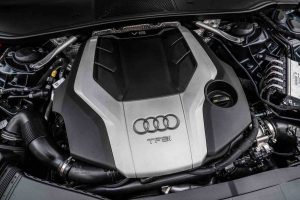
The reason for all of that being the regulatory pressure car companies are under to find a way to continue selling gas engines at all. The government is Hell-bent on driving them off the roads by driving them out of the showrooms – in favor of cars that emit no gas at all – at the tailpipe – i.e., electric cars. So it’s not about gas mileage – or consumer demand. It is about complying with the demands of the government.
Anyhow… .
The high-torque belt starter (like the flywheel-mounted starter-generator used by BMW and Benz) can spin the gas engine back to life much more quickly (and quietly) than a traditional starter bolted to the flywheel and powered by just 12 volts. It can also turn the engine off – and back on – more often. As when the car is decelerating, for instance. Pretty much anytime the driver takes his foot off the gas, the gas engine is shut down.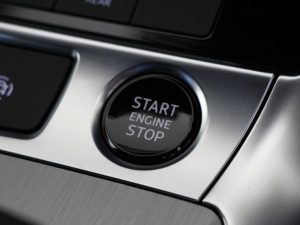
It comes on again, as needed – without noticeable sturm or drang.
Also without much noticeable gas mileage uptick.
The 2.0 hybrid-powered version of the A6 carries an EPA rating of 23 city, 32 highway. To give you a sense of how much – or rather, how little – has changed – in terms of MPGs – the 2017 A6, which came with just the 2.0 liter engine (paired with an eight speed automatic) rated 22 city, 32 highway.
The new/hybridized version of the 2.0 engine does however carry a higher horsepower rating – 273 vs. 252, previously. But this gain is largely cancelled out by the additional weight (and cost) of the 48 volt battery pack.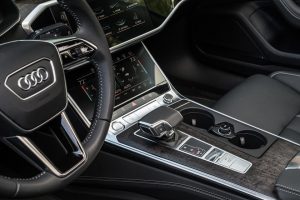
It’s a similar story with the optional 3.0 liter V6.
In mild hybrid form this engine makes 335 horsepower and delivers 21 city, 30 highway. In old form – with a supercharger rather than a 48 volt electrical system and belt-driven starter – the 3.0 engine made 333 horsepower (back in 2017) and delivered 21 city, 29 highway.
Split the no difference.
So what is the gain?
Speak, rather of reduction – of gas. The dread gas, C02 – held to be turning the planet into a soon-to-be-flooded waterworld, notwithstanding that the politicians who claim it’s so continue to buy properties on the water.
Hmmmmm. . .
Regardless, the car companies must feign belief in this new religion – or at least, find a way to comply with the regs demanding the emitting of less and less of the dread gas. Going hybrid to one degree or another is the only way to do that – shy of going all-electric – and most of the car buying public cannot afford (or doesn’t want) that because it doesn’t want to hang around a “fast” charger for 30-45 minutes playing Candy Crush when they could just gas up and be gone in five minutes or less.
Desperation can produce near-miracles.
During the last months of WWII, the Germans managed to get bat-winged jet interceptors flying and had been launching the first ballistic missiles, precursors to those which sent Americans to the Moon a quarter-century after the Germans lost the war. The new war – agains internal combustion – has imposed similar desperation and resulted in similar near-miracles to keep the gas engine going, at least a little while longer.
The belt starter system developed by Audi and the functionally similar systems developed by Mercedes and BMW do a miraculous job of maintaining the miracle of internal combustion – with all its ease and convenience – in the face of the relentless push (by the government) to replace it with the inconvenience of electric powertrains.
What’s happening under the hood – as you drive – is a microcosm of what’s going on in the world, which is a struggle to the death between IC and EV, with the IC being pressured to take a dive by the bookies. The gas engine powers off – a kind of micro-death – and the car coasts on, propelled by the inertia provided by the gas engine, the life of accessories maintained via the electrics until the gas engine comes on, again.
You do not notice these transitions unless you’re paying very close attention – mostly to the instruments, which reveal the cycling on and off. It is hard to discern them by feel or ear – which is the miracle. For now, you get to have what you want – that being not having to stop for 30-45 minutes to play Candy Crush at the “fast” charger every other day while your electric car recovers some of its charge. And you have the enjoyment – for those who still enjoy such things – of engine sounds rather than the sound of silence.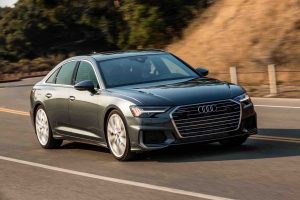
There is also shifting, which is something most EVs don’t do because most EVs do not have transmissions. They are direct drive, which is the same as single speed. The motor spins, the wheels turn – that’s it. Some admire this while others rue it – missing the orchestra of movement that until now defined the experience of driving a car as opposed to driving a golf cart.
Interestingly, the Audi’s seven speed automatic has one less gear than the old (pre-hybrid) Audi had, which was eight. The new Audi makes up for the loss of one overdrive gear via the more efficient gearing of the seven speed’s dual clutch set-up, which shifts gears faster and so more efficiently than the old A6’s conventional/hydraulic transmission with its planetary gears. It doesn’t translate into any meaningful mileage gains – as per above – but it does feel snapper when it shifts, which is meaningful in another way.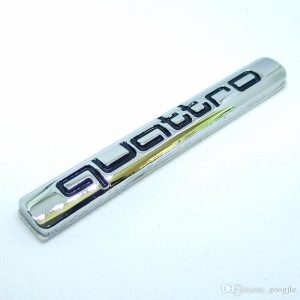
There used to be a very noticeable difference between cars – like Audis – built on a front-drive-based layout (with transverse or sideways-mounted) engines and rear-drive-based cars (with longitudinal or front-to-rear-mounted engines) like the Benz E and BMW 5, even when both were equipped with AWD.
The FWD-based cars tended to oversteer when pushed while the RWD-based cars were more inclined to oversteer – the latter being considered more enjoyable by people who enjoy pushing a car in the curves. But the near-ubiquity of AWD has greatly mellowed out these former differences and the ubiquity of electronics that cancel out wheelspin and torque steer render the differences almost indistinguishable – unless you go to the trouble of turning off the electronics (if you’re allowed to) and have the gumption to really push the car – which most people can’t due to traffic, fear of cops or simple common sense.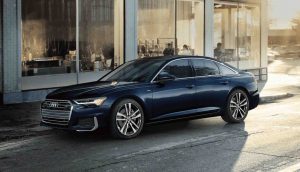
The Audi’s chassis differences – vs. the rear-drive-based Benz and BMW – are thus rendered near-irrelevances.
What’s pertinent is that this Audi comes standard with the AWD that is optional in the above – and for substantially less than it costs to equip the above with their available AWD systems.
Arguably, AWD has been oversold as most people do not live in the Rockies – or even Minnesota – and don’t have to ford their way through heavy snow for months out of every year.
But at least here, it sells for less.
One thing that remains traditional is the understated appearance of the Audi’s exterior. It is well-dressed, not over-dressed. Some of the others have the look of a guy wearing a tuxedo to Chipotle.
Or parachute pants to church.
It is on the inside that this Audi gets radical.
Everything is displayed virtually – which is really a misnomer since the information is actually displayed. But it is displayed electronically, via flat screens. This of course is not unique to Audis – this one or other ones. All new luxury cars and even many just cars now have similar “virtual” cockpits.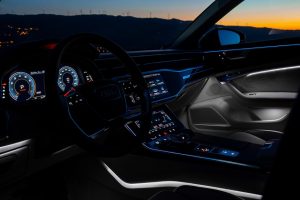
Where the Audi differs is in how the information is displayed. Particularly road/GPS info, which is overlaid in what is arguably the most visually attractive and functionally coherent “Google Earth” style you’ll find in any car. You view what’s ahead almost as if you were viewing it from a satellite, focusing in (or out) on what’s coming up or all around. It is a legitimate adjunct to driving, rather than a distraction from it.
There are two additional touchscreens, too – both mounted to the right of the driver, in the center stack. One is for the climate controls and the other is for the audio/infotainment/apps. At night, with all three glowing cheerily, you can imagine yourself as Mr. Data laying in a course for the Alpha Quadrant on the bridge of the Enterprise – Next Generation.
Being able to get massaging seats in a mid-tier luxury sedan is a happy thing; formerly, these were available only in top-of-the-line sedans, such as the A8 (in Audi’s case) and the Benz S and BMW 7, in those cases.
One thing you can’t get in this Audi is more trunk space, which is probably this car’s main deficit. Just 13.7 cubic feet, which is about what you’d typically find in a compact-sized sedan and much less than you’ll find in some other luxury sedans in the mid-sized class, such as the BMW 5 (which has a huge 18.7 cubic foot trunk).
On the other hand, some of the others in this class – like the Benz E sedan – have even smaller (13.1 cubic feet) trunks.
On the other (other) hand, Audi could remedy this failing by offering the wagon (Avant) version of the A6 you can buy in Europe – but which isn’t available here.
The Bottom Line
The tug-of-war between gas – and electric – continues.
Too bad it’s not a fair fight.
. . .
Got a question about cars, bikes, or Sickness Psychosis? Click on the “ask Eric” link and send ’em in! Or email me at EPeters952@yahoo.com if the @!** “ask Eric” button doesn’t work!
If you like what you’ve found here please consider supporting EPautos.
We depend on you to keep the wheels turning!
Our donate button is here.
If you prefer not to use PayPal, our mailing address is:
EPautos
721 Hummingbird Lane SE
Copper Hill, VA 24079
PS: Get an EPautos magnet or sticker or coaster in return for a $20 or more one-time donation or a $10 or more monthly recurring donation. (Please be sure to tell us you want a magnet or sticker or coaster – and also, provide an address, so we know where to mail the thing!)
My eBook about car buying (new and used) is also available for your favorite price – free! Click here. If that fails, email me at EPeters952@yahoo.com and I will send you a copy directly!


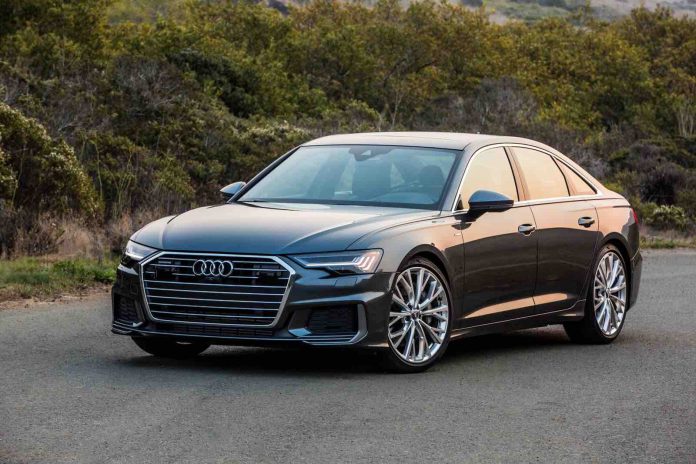



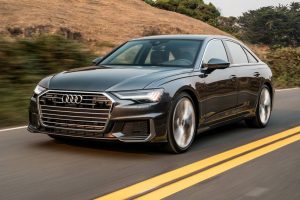
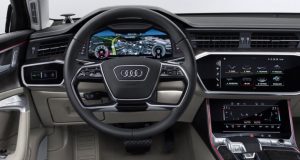
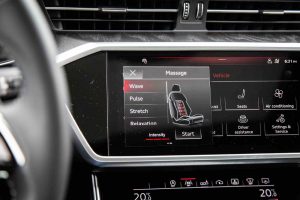








I’m going to keep my (modestly “electronic”) 2004 Audi A8L until it bankrupts me. Favorite car I’ve ever owned. A money-pit and a pain in the ass, but I cannot kick it to the curb. Drives as an extension of ME. That is what I love about Audi’s in general.
Although, I’ve read that the original A8 (called the Audi “V8”) was hands-down the absolute BEST in the snow. I had my chance to get a 1992 version but lost out. Would have been great, as I would have qualified for “retro” or “historic” classification, which would have let me bypass big brother every two years for inspection. But getting parts for maintenance likely would have given me major problems down the line.
As much as Audi has become cucked over the past decade – they’re still one of the best car companies remaining. We’re screwed overall.
Amen, NJR –
I’ve driven a lot of new Audis over the years – practically every model, in fact, from the mid-’90s through today. The peak – in my opinion – was in the late ’90s/early 2000s. Superb in every way. The current crop is anesthetic relative to what was on offer as recently as five or six years ago. It’s all very sad…
Eric, you know whats pissed me off about Audi ? After ages of having a BMW was considering getting one (the SQ5 – quite powerful, handles well, built like a german, and diesel). You know what turned me off – the twin exhaust out the back – WAS FAKE !! Can you imagine – fake exhausts on a performance car !!! When even Kia has real exhausts ! As stupid as it sounds – this was the deal breaker and I stayed away!! I find it hard to deal with things which are not genuine – but none more so than fake exhausts… why are they doing that !??! Why do they even bother !?! Especially on a so called premium performance car !!
anon 1
Thia Audi is way better then a Tesla, at least the residual value after 10 years isn’t zero…..and it makes nice sounds, way better build quality, far nicer looking, no long waits for recharging…longer range…doesn’t eat up tires like a tesla…
I still want an A6 Allroad and I’m also resigned to “never EV”. So it looks like time is running out for me. Of course, I could always get a used low-mileage one but, as the latest diktats hit, the price on those is likely to not budge much from new in the first place.
If about $20K would drop out of the sky into my lap, I’d be good to go. But under the economic conditions we’re seeing, I’m not likely to come up on that anytime soon.
The games not over yet but time is getting short.
It’s amazing to me the the car companies never even whimpered about the damage these useless regulations have and will inflict on the industry and public. They just dropped to their knees with their mouths open. This Man Made Climate Change scam is even more easily proven wrong than the Covid scam yet everyone is silent.
I believe that they (car comp.) know that regulation is their only way to survive. My premise is that if they kept building say a 1997 Chevy truck, or 2005 diesel engines, etc.., the 3rd world eventually catches up and you could buy a 1997 chevy truck from Brazil, etc… for half price. Hence they have to keep the regs/emmisions, etc… rising to keep the 3rd world out.
I think the E car push though is going to back them into a corner. The only way out of having these made in the 3rd world is too keep the ‘safety’ crap regs advancing, which they are currently doing. Just my 2 cents.
egads that drivetrain is a complicated mess. No way these things stay running in later years/mileage.
What a mess big biz/gov has made of things.
It’s kind of ironic that an electronically commutated version of the CIBA/Bosch Dynastart is the saviour of the modern ICE…
http://www.isettadoc.com/files/dynastart.pdf
Back in the 50’s and 60’s, folks with such a starter/generator in their vehicles usually wished they didn’t. Lots of brush and commutator maintenance, and shorted field windings.
Now, the commutation, rectification, and control is electronic, but the principle is the same. And, the desire to not have to have the modern version in my car is even stronger.
One more observation. That A6 drivetrain picture looks like it’s longitudinal AWD/FWD, vice transverse. Generally, longitudinal FWD does not exhibit the evil FWD twins of torque steer and understeer in as great a quantity as transverse FWD (with unequal length halfshafts). Ponderous steering effort, yes, demanding power boost, but unless the suspension is poorly set up, mostly benign understeer characteristics in my experience.
Front engine RWD also can exhibit strong understeer, if underpowered and/or the suspension setup favors it. Now, big rip snorting Ponchos with 389’s in front are the poster children for the power induced oversteer burnout, and rightly so. (Heart beating faster just typing that) But, even my lightweight moderately-powered MGB is capable of very sudden power-induced oversteer (due to weight balance and suspension characteristics mostly), so a lot depends on the suspension design.
I always noticed the Audis and VWs in the standard front wheel drive setup tend to understeer when pushed hard on a bend. Always thought this was due to the front wheel drive. I think in the article you write both FWD and RWD cars oversteer. Thought RWD ones are more inclined to understeer (though I agree most modern cars with all the electronic trickery its hard to tell). I can only tell the thing with the VAG cars because there are some higher speed roundabouts and bends on wide and empty roads around where I live where one can push them a bit 😀
Almost a negligible improvement in fuel efficiency when incorporating a mild hybrid system. Audi needs to do better. Why pay extra for an expensive additional system, which probably also costs and arm and a leg to repair, to gain (almost) nothing?
Hi Jone,
It’s not about gas mileage – which is an irrelevance in cars of this type (anyone who spends $50k-plus on a car needs to worry about “saving money” like the ocean needs to worry about drying out). It’s a way for Audi to be able to continue selling cars of this type. Without going all-electric.
Well, at least this improved “mild Hybrid” system is much better than the early start/stop systems without automatic transmission, which quite frankly made me really nervous in “stop and go” traffic.
I realize that VW and Skoda offer these systems in reasonably priced cars as well, so perhaps I was too negatively prejudiced.